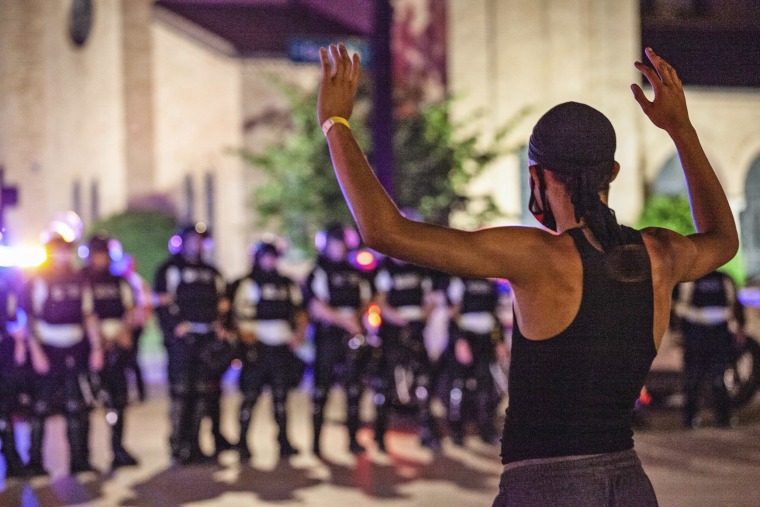A federal judge on Friday issued a preliminary injunction against Columbus police preventing them from using force against non-violent protesters, writing that officers ran "amok" during protests in the city last year.
Algenon Marbley, chief judge for the Southern District of Ohio, began his 88 page opinion with a quote from Martin Luther King, Jr.: "But somewhere I read of the freedom of assembly. Somewhere I read of the freedom of speech. Somewhere I read of the freedom of press. Somewhere I read that the greatness of America is the right to protest for rights."
"Unfortunately, some of the members of the Columbus Police Department had no regard for the rights secured by this bedrock principle of American democracy," Marbley wrote. "This case is the sad tale of police officers, clothed with the awesome power of the state, run amok."
The decision favored 26 plaintiffs who sued the city after participating in protests last summer following the death of George Floyd at the hands of police in Minneapolis. The lawsuit alleges that while they were peacefully demonstrating, "officers engaged in collective punishment by indiscriminately pepper-spraying, tear-gassing, or shooting wooden bullets."
"What is more, [officers] sometimes failed to give audible warnings or adequate time to disperse before resorting to less-lethal force," Marbley wrote.
Now, Columbus officers are banned from using those methods of "non-lethal force" against non-violent protesters, which also includes body slams, flash-bang grenades, rubber bullets, batons and pushing against nonviolent protesters, the judge ruled.
Nonviolent protesters include those who are chanting, verbally confronting police and occupying streets.
The injunction also requires officers to ensure "that body and vehicle cameras are in good working order and used during every interaction with nonviolent protestors" and that their badge numbers and identity cards are visible during interactions with protesters.
And officers must recognize that people displaying “press,” “media,” “reporter,” “paramedic,” “medic,” “legal observer,” or similar words or symbols are allowed to record at protests and help protesters who appear to be injured, the judge ruled. Further, anyone can record at a protest.
"Multiple witnesses testified to their physical and emotional injuries suffered at the hands of CPD officers while exercising their fundamental rights to assemble and protest" last year, Marbley wrote.
One man, a plaintiff who was protesting peacefully, was struck by a projectile at the same time police ordered protesters to disperse, video shows, according to the injunction.
"In other words, there was no time for protestors to react," Marbley said.
The 31-year-old man's knee was shattered "into many little pieces" and he was unable to walk for five months, according to the judge's order. He still cannot walk for more than half a mile without "significant pain."
Another woman, who was looking for her 21-year-old daughter but did not intend to protest, was pepper sprayed twice, even as she told officers she simply "wanted to find my baby," she recounted, according to the judge's order.
After she was sprayed a second time, she sat down on a sidewalk, screaming for help because she could not see.
"She discerned two officers were walking towards her in riot gear; she hoped help was on the way at last. Instead, CPD officers sprayed her again — now, for the third time," the document said.
Then she says an officer stomped on her kneecap and said: "That’s what you get for being down here, you black, protesting b----."
The Columbus Police Department did not immediately respond to requests for comment Friday.
A report commissioned by the city council and released earlier this week criticized both the police department and city leaders, saying Columbus was unprepared for the size and energy of the protests.
Mayor Andrew Ginther and City Attorney Zach Klein on Thursday requested a Justice Department investigation into the police force following a series of police killings of Black people and other controversies.
“This is not about one particular officer, policy, or incident; rather, this is about reforming the entire institution of policing in Columbus," Ginther and Klein said in Wednesday's letter. "Simply put: We need to change the culture of the Columbus Division of Police.”
The request follows the April 20 fatal shooting of 16-year-old Ma'Khia Bryant. Bryant was Black and the rookie officer who shot her was white. Police picked up what appeared to be a knife near the girl's body after the shooting. In body camera video, Bryant is seen holding an object and appears to swing at another person with it.
Tensions were already high in Columbus after the high-profile shootings of Casey Goodson, Andre Hill and Miles Jackson in the past year.
Records show that Black residents, about 28 percent of the Columbus population, accounted for about half of all use-of-force incidents from 2015 through 2019, according to The Associated Press.
Amid the controversies surrounding the shootings, Columbus Police Division Chief Thomas Quinlan stepped down in January after a brief one-year tenure. Quinlan was also criticized for his handling of protesters. More than 14,000 people signed a petition calling for his resignation, which said that Quinlan directed officers to use tear gas and mace on protesters.

